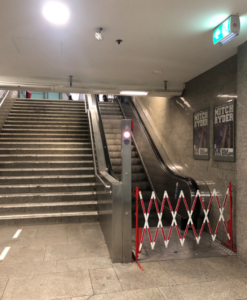 Imagine this: You’re waiting for the next train to Berlin Alexanderplatz at the train station Friedrichstraße. But before the train even stops, you let out an annoyed sigh. Not again, you think. It’s one of those old train cars, the ones with a step. Now you ask a strong-looking person for help, and even though it’s Berlin (which is not known for being the friendliest place in Germany), the person is willing to lift the front part of your wheelchair to help you get onto the train. Two stations later, you have to ask someone else for help to get off the train.
Imagine this: You’re waiting for the next train to Berlin Alexanderplatz at the train station Friedrichstraße. But before the train even stops, you let out an annoyed sigh. Not again, you think. It’s one of those old train cars, the ones with a step. Now you ask a strong-looking person for help, and even though it’s Berlin (which is not known for being the friendliest place in Germany), the person is willing to lift the front part of your wheelchair to help you get onto the train. Two stations later, you have to ask someone else for help to get off the train.
This is the reality for many people in any major city. But it’s not just trains – it’s the subway, the bus, and even train stations themselves that make public transportation a living hell for many individuals. Especially in Berlin, where every quarter moon half of the subway lines seem to be under some sort of repair, and a big sign at the train station announces Schienenersatzverkehr (rail replacement service), which means you have to use five different busses to get to your destination.
We often don’t have disability on our radar until we are confronted with similar problems: walking around with an elderly person or even a baby stroller can be challenging when elevators aren’t there or aren’t working. In the European Union, around 80 million people have a disability. According to the Center for Disease Control and Prevention, one in seven adults in the U.S. has a disability that affects their mobility. But even if the numbers were smaller, accessibility should always be a priority when constructing or renovating buildings or when planning public transportation.
The truth is that even though accessibility has been improving in Berlin and elsewhere, it still isn’t acceptable. The Berliner Verkehrsbetriebe (BVG) set out to make almost all train stations accessible by 2022, and they have invested around 60 million Euro into accessibility since 2019. But the last verified numbers I could find on the BVG website indicate that only around 78% of the subway stations can be accessed without stairs. The problem is how we view the situation: Is the glass half full or half empty? More than half of the tram stations are accessible, and all busses have ramps. All new subways are now on ground level. However, that’s still only 40% of all the subways. 73% of the subway stations have tactile paving, but what about the other 27%?
Similar to Berlin, New York City is also trying to make their subway system more accessible. With the addition of 11 new stations in 2020, there are now more than 130 accessible stations. There is also an Elevator and Escalator status webpage, which informs the user of any elevator outage. Unfortunately, the NYC bus system has not made much more progress than Berlin’s. If a person in a wheelchair seeks access, the bus driver is required to deploy a ramp and secure the wheelchair in position inside the bus and also free it upon exit. In Berlin, new bus stops are being tested that have an average curb height of 22 cm, meaning that a person would not need a ramp in order to get onto the bus. There would be no need for another person or the bus driver to help. How many of those bus stops exist, I cannot verify but if they work, they do seem to be a great alternative.
In general, changes seem to be coming far too late and far too slow. Even though the BVG and the Deutsche Bahn – which is responsible for the S‑Bahn in Berlin and most intercity and regional trains in Germany – have set their goal on making all public transportation accessible, realistically speaking it might still take decades. So, let’s all try to raise awareness, e.g. via public campaigns or donations to associations for the disabled like the AAPD (American Association of People with Disabilities) or the BBV (Berliner Behindertenverband). Even though you might not be directly affected, we all should be interested in a more just and inclusive society with access for all.
6,384 Total Views, 8 Views Today






